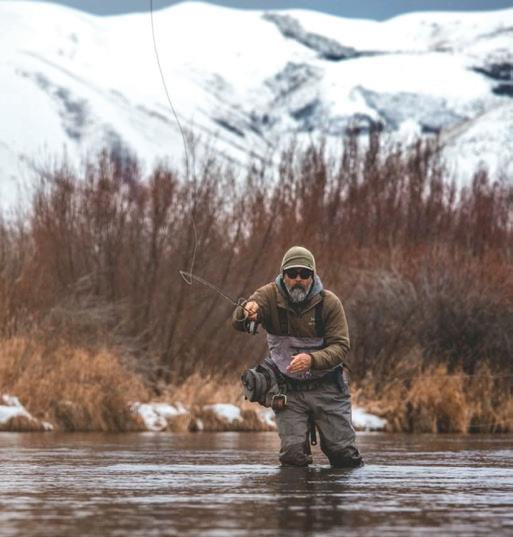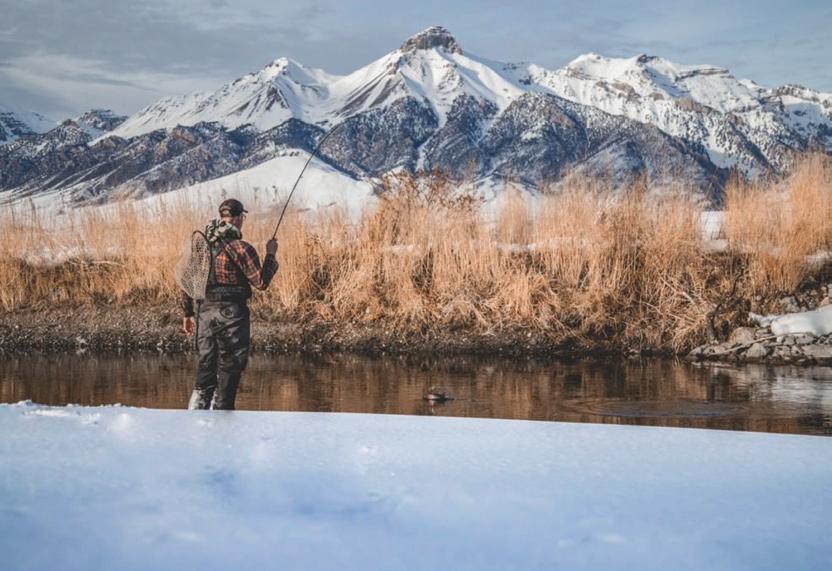
4 minute read
Winter Fly Fishing Paradise
BY MIKE MCKENNA | PHOTOS BY SILVER CREEK OUTFITTERS
“It’s really important, especially in the winter, to be a thoughtful angler, to be a good Idaho angler,” Pete DeBaun said.
“Big Pete,” as he’s known, has been a fly fishing guide for over four decades. Many of those years have been with Ketchum’s legendary fly shop, Silver Creek Outfitters. An ordained Presbyterian minister, Big Pete certainly knows how to preach the gospel about fly fishing.
“Idaho has the most gracious anglers I’ve ever seen,” said Big Pete, who’s fished in over 40 countries. “Idaho anglers are friendly, thoughtful and respectful. They respect the resource, respect the fish and want to protect the experience for others to enjoy for years to come. And if they’re not acting that way, then they don’t know what Idaho is all about.”
Idaho and Sun Valley in particular, are all about fly fishing, even during the winter. In fact, some of the best angling of the year in the mountains of south-central Idaho happens as winter gives way to spring. There are two impressive species to chase after–trout and steelhead.
Trout
“March is one of my favorite times of the year to fish,” Big Pete said.
The Big Wood and Big Lost rivers are both open to catch and release fishing until the end of March. Swinging streamers and bouncing nymphs beneath the surface are both effective in any weather, as the majority of what trout eat is subsurface. But there’s nothing like catching fish on dry flies.
“Winter fishing is an interesting deal. When you’re a dry fly guy you’re searching for that hot fish, the one that’s got the energy to feed off the surface. Then you have to sneak up on it and make a near perfect cast,” Big Pete said. “It’s a challenge, but it can be very rewarding.”

The reward is a big part of what Big Pete is trying to help redefine about fishing.
“I always give my guests a set of rules before we go out, especially in the winter. One of them is redefining what a catch is,” Big Pete explained. “It’s not about bringing a fish to hand. It’s about getting that fish to take your fly, coming tight, and the relationship you have in that moment with that animal. As they say, ‘the tug is the drug.’”

In this Instagram age, even the most thoughtful angler likes to get “Let it an occasional photo. When that’s the go with a case, Big Pete recommends bringing the fish in quickly, using heavier thank you line and leader helps. Use a large, rubber-coated net and unhook the very much fish quickly. Keeping it wet, primarily and aloha.” the gills, is also extremely important during the colder months. After you’ve quickly gotten the photo, it’s time to release, always cradling and never grabbing the fish.
Or as Big Pete puts it, “Let it go with a thank you very much and aloha.”
Steelhead
“Steelheading is a such sensitive subject. They’ve made steelhead are known as the “fish of a thousand casts.” an 810 mile journey, one of the longest anadromous runs “The real enjoyment of steelheading is hunting for them, in the world to get to Idaho and then we start casting for sight fishing for them, in clear water, making a good cast them,” Big Pete said. “That’s why part of steelheading is and then watching the take,” said Big Pete, who guides in about being a good aquatic citizen.”
Steelhead are sea-run rainbow trout. The Salmon Steelhead aren’t necessarily eating during their long trek River once teemed with steelhead. But much like the fish home to the heart of Idaho. So it’s always important to that Idaho’s most famous river is named for, steelhead “put the fly right on their nose,” as Big Pete explained. numbers have been dwindling for decades. The majority It’s also important to treat steelhead with great care. You of the steelhead that lucky anglers catch in Idaho now are hatchery bred and don’t have an adipose fin. It’s been clipped.

Their scarce numbers are just one of the reasons that steelhead are known as the “fish of a thousand casts.”
“The real enjoyment of steelheading is hunting for them, sight fishing for them, in clear water, making a good cast and then watching the take,” said Big Pete, who guides in the waters around Stanley.
Steelhead aren’t necessarily eating during their long trek home to the heart of Idaho. So it’s always important to “put the fly right on their nose,” as Big Pete explained.
It’s also important to treat steelhead with great care. You should always assume the fish on your line is a wild one until you know otherwise. Big Pete is a fan of adopting the rule used among tarpon guides, where a hook and jump are enough to count as a catch.
“The really thoughtful angler will adjust his expectations in the winter or when steelheading,” Big Pete said. “The joy is fooling the fish and getting the line tight. Ego ruins fishing more than anything else.”
The spring run of steelhead on the Upper Salmon River can go from March to late April or early May. The Idaho Department of Fish & Game tracks steelhead creel rates on their website.
As Big Pete summed it up, “It’s one of the truly unique joys of fishing in Idaho.”










